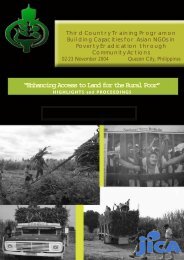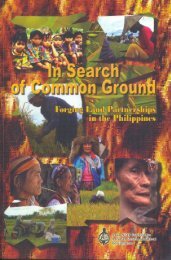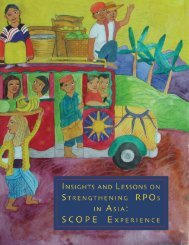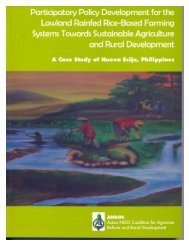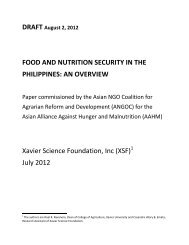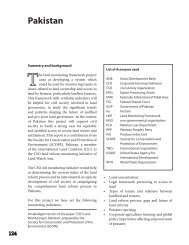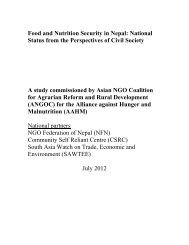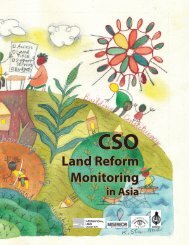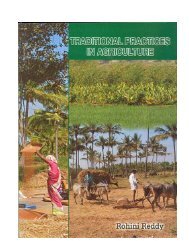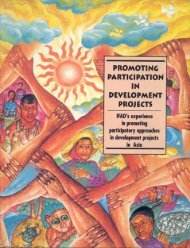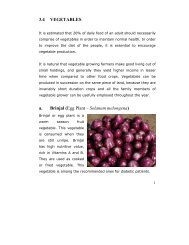Securing the Right to Land FULL - ANGOC
Securing the Right to Land FULL - ANGOC
Securing the Right to Land FULL - ANGOC
Create successful ePaper yourself
Turn your PDF publications into a flip-book with our unique Google optimized e-Paper software.
Table 2. con’t.<br />
Nepal<br />
Interim Constitution of 2007<br />
Three-Year Interim Plan<br />
2007–2009<br />
Agriculture Perspective Plan<br />
(1996-2010)<br />
Philippines<br />
1987 Constitution<br />
Comprehensive Agrarian Reform<br />
Law (CARL) of 1988 or<br />
Republic Act (RA) 6657<br />
Indigenous Peoples’ <strong>Right</strong>s<br />
Act (IPRA) or RA 8371<br />
THE PROLONGED STRUGGLE FOR LAND RIGHTS IN ASIA<br />
21<br />
Committed <strong>to</strong> “pursue [a] policy of scientific land reform programs by gradually ending capitalistic<br />
land ownership practices.”<br />
Mandated <strong>the</strong> State <strong>to</strong> pursue a policy of providing adequate land and livelihood <strong>to</strong> freed<br />
bonded laborers<br />
Aimed <strong>to</strong> improve farmers’ standard of living and contribute <strong>to</strong> <strong>the</strong> national economy through<br />
<strong>the</strong> implementation of scientific land reform<br />
Set <strong>the</strong> specific goal of ascertaining <strong>the</strong> land rights of landless slum dwellers, freed bonded<br />
laborers, and tenants, <strong>to</strong> ensure food security, address poverty, and make land more productive<br />
Outlined an implementation strategy that includes <strong>the</strong> formulation of appropriate laws and<br />
<strong>the</strong> setting up of mechanisms <strong>to</strong> distribute land <strong>to</strong> landless groups<br />
Sought <strong>to</strong> form a high-level Commission <strong>to</strong> resolve problems concerning landless groups<br />
Main thrusts are enhancement of land productivity, commercialization of agriculture, diversification<br />
of products, and focusing on products in which Nepal has a comparative advantage<br />
Identified dual ownership of land and land fragmentation as major constraints <strong>to</strong> agricultural<br />
development and recommends taking actions <strong>to</strong>ward terminating dual land ownership<br />
and initiating land consolidation.<br />
Laid down <strong>the</strong> principles that serve as <strong>the</strong> overall framework for <strong>the</strong> issue of access <strong>to</strong> land:<br />
protection of property (but property can be taken away for public use with due process and<br />
just compensation); promotion of social justice and human rights; promotion of rural development<br />
and agrarian reform; and promotion of <strong>the</strong> rights of indigenous communities <strong>to</strong> <strong>the</strong>ir<br />
ancestral lands.<br />
Expanded agrarian reform <strong>to</strong> all agricultural lands regardless of crop planted under <strong>the</strong> Comprehensive<br />
Agrarian Reform Program (CARP). It targeted <strong>the</strong> redistrbution of 8.1 million hectares<br />
of agricultural land and integrated social forestry areas (ISF) <strong>to</strong> 3.9 million landless tenant<br />
farmers and farm workers over an initial 10-year period.<br />
Provided for different tenurial instruments based on land classification: tenurial security for<br />
forestry areas, and tenancy reforms and land redistribution for private and alienable lands.<br />
<strong>Land</strong> redistribution is <strong>to</strong> be complemented by <strong>the</strong> delivery of support services like extension,<br />
credit, infrastructure facilities and livelihood assistance.<br />
Imposed a five-hectare retention limit for <strong>the</strong> landowner and provides three hectares for<br />
each heir actually tilling <strong>the</strong> land.<br />
Recognized, promoted and protected <strong>the</strong> rights of indigenous cultural communities/ indigenous<br />
peoples (ICCs/IPs); served as <strong>the</strong> basis for IP’s land rights, which are recognized through<br />
<strong>the</strong> issuance of a Certificate of Ancestral Domain Claim (CADC) or a Certificate of Ancestral<br />
Domain Title (CADT).<br />
ASIAN NGO COALITION FOR AGRARIAN REFORM AND RURAL DEVELOPMENT



